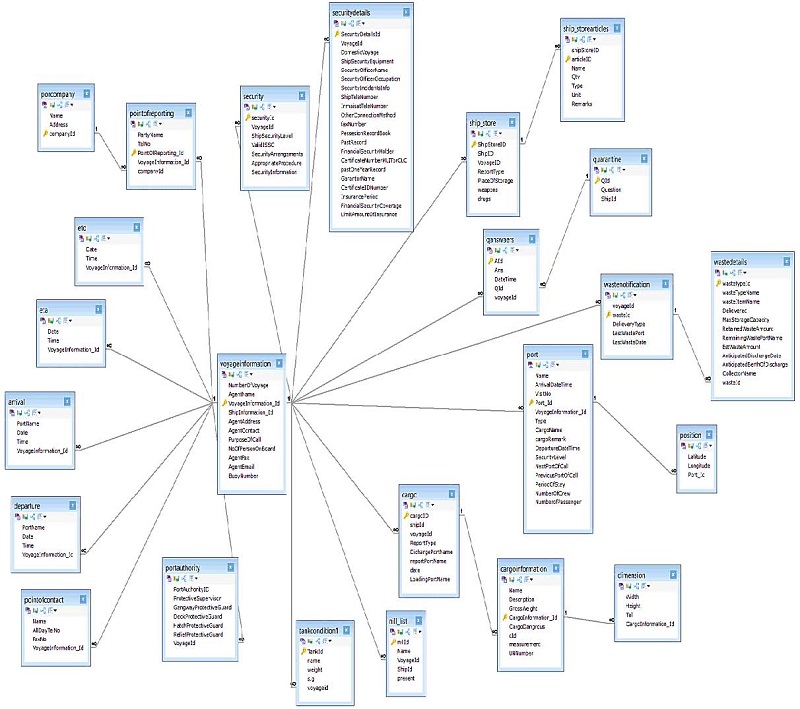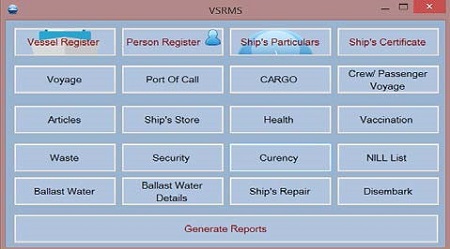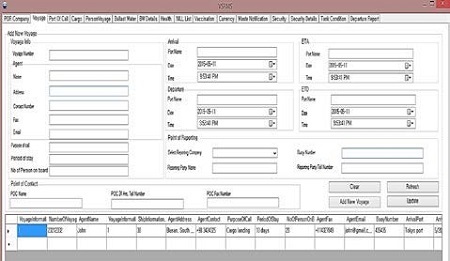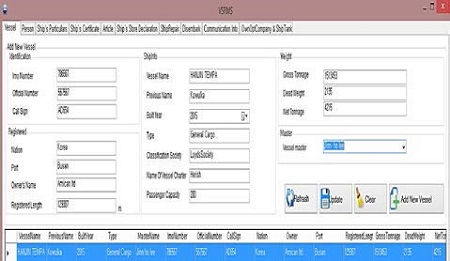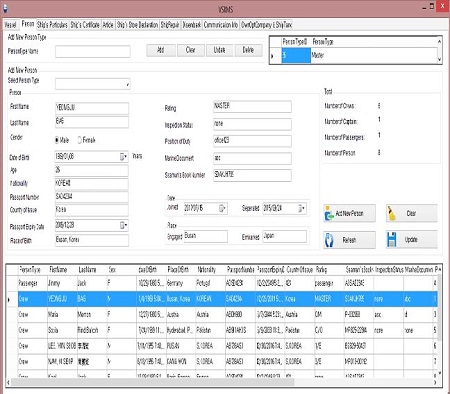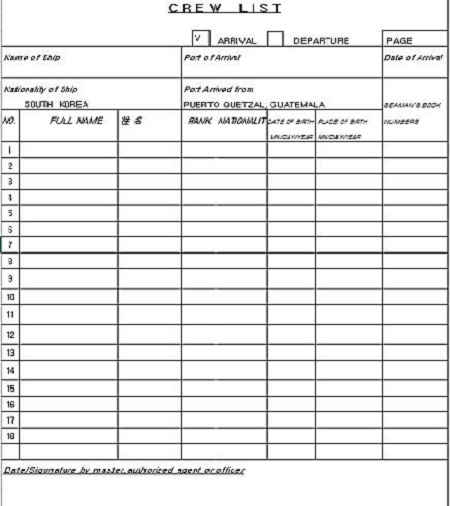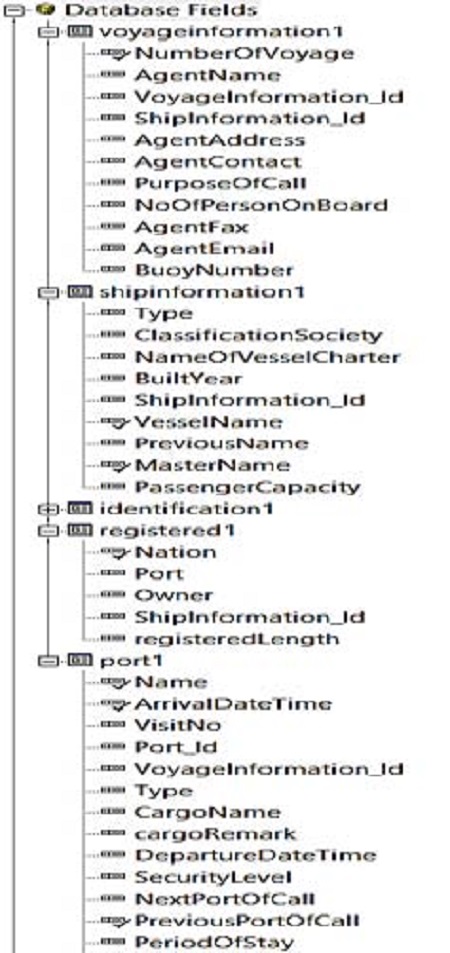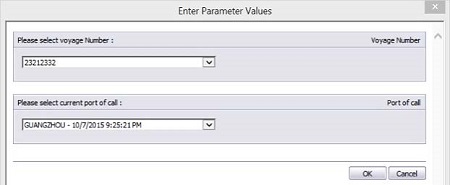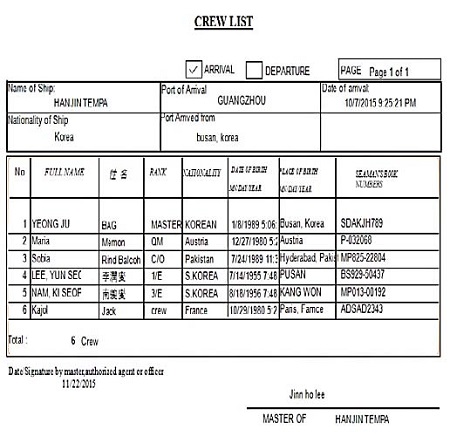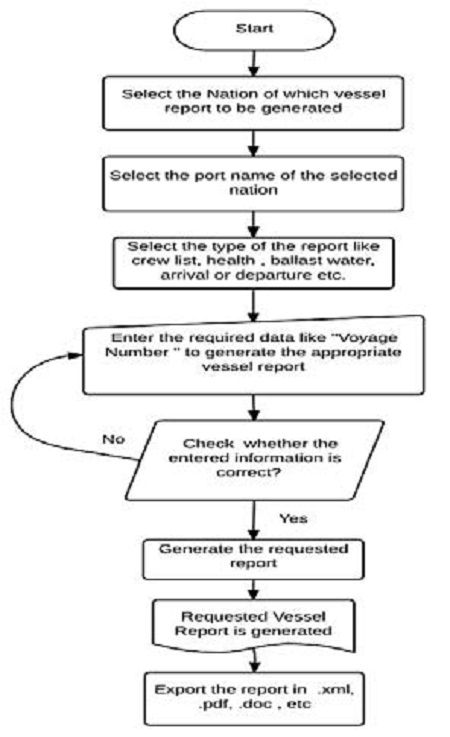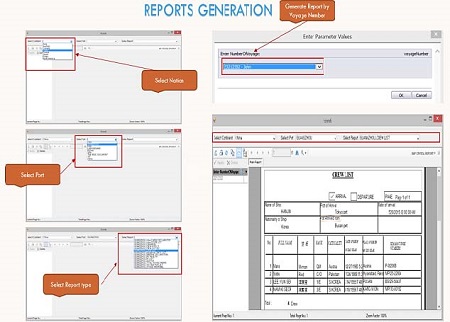
Study on development of vessel shore report management system for IMO MSP 8
Copyright © The Korean Society of Marine Engineering
This is an Open Access article distributed under the terms of the Creative Commons Attribution Non-Commercial License (http://creativecommons.org/licenses/by-nc/3.0), which permits unrestricted non-commercial use, distribution, and reproduction in any medium, provided the original work is properly cited.
Abstract
In this study, a Vessel Shore Report Management System (VSRMS) is developed for the International Maritime Organization (IMO), Maritime Service Portfolio (MSP) Number 8, which comprises vessel shore reporting. Several documents have to be completed before the arrival/departure of a vessel at a port, as each national port has its own reporting format and data. The present vessel reporting system is inefficient, time-consuming, and involves excessive paperwork, which results in duplications and errors. To solve this problem, in this study, the vessel reporting formats and data contents of various national ports are investigated, as at present, the reporting documents required by the current IMO standard includes insufficient information which is requested by national ports. Initially, the vessel reporting information of various national ports are collected and analyzed. Subsequently, a database structure for managing vessel reporting data for ports worldwide is devised. To make the transfer of data and the exchange of information of vessel reports much more reliable, efficient, and paper-free, VSRMS, which is a software application for the simplification and facilitation of vessel report formalities, is developed. This application is developed using the latest Microsoft C#.Net Programming Language in the Microsoft Visual Studio framework 4.5. It provides a user interface and a backend MySQL server used for database management. SAP Crystal Reports 2013 is used for designing and generating vessel reports in the original report formats. The VSRMS can facilitate vessel reporting and improve data accuracy through the reduction of input data, efficient data exchange, and reduction of the cost of communication. Adoption of the VSRMS will allow the vessel shore reporting system to be automated, resulting in enhanced work efficiency for shipping companies. Based on this information system and architecture, the consensus of various international organizations, such as the IMO, the International Association of Marine Aids to Navigation and Lighthouse Authorities (IALA), the Federation of National Associations of Ship Brokers and Agents (FONASBA), and the Baltic and International Maritime Council (BIMCO), is required so that vessel reporting is standardized internationally.
Keywords:
MSP 8, IMO, VSRMS, Vessel reports1. Introduction
The e-Navigation Strategy Implementation Plan (SIP) is currently being developed by the International Maritime Organization (IMO) for the analysis of user requirements. By comparing user needs with the present status, the discrepancies between them were identified and nine solutions were determined to solve the discrepancies. Among the nine solutions, five were selected, which are S1–S4 and S9, through the prioritization of importance and urgency. Using FSA (Formal Safety Assessment, which was submitted by Norway, seven RCOs (Risk Control Options) were determined and consequently 16 MSPs (Maritime Service Portfolios) were derived. During the procedure, not only the Sub-Committee on Navigation (NAV) in the IMO e-Navigation CG (Correspondence Group), but also various international organizations, such as the International Hydrographic Organization (IHO) and the International Association of Marine Aids to Navigation and Lighthouse Authorities (IALA), played an important part [1].
After establishing the e-Navigation infrastructure, IT Services will be provided to enhance safe and economic navigation. IT Services or Maritime Service Portfolios (MSPs) should be sufficiently reliable and effective for the safety of navigation. Table 1 shows 16 MSPs that have been derived by the IMO after many logical processes and much debate. This paper focuses on MSP number 8, which comprises vessel shore reporting of the IMO. The IMO has ratified the Convention on Facilitation of International Maritime Traffic (FAL) to implement a standardized document format for the arrival/departure of ships. In this study, FAL.5-Circ.36, which covers the guidelines for setting up a single window system in maritime transport, was reviewed [2]. These guidelines do not define any particular standard of ship reporting information in order to implement a Single Window System (SWS). A significant problem as ships travel between many ports is that they are required to complete many different ship reports in different formats, since ports in different nations do not follow any standard reporting data format.
In the case of the Norwegian SafeSeaNet (SSN), which is part of the European SafeSeaNet, a vessel and voyage reporting system intended for use by commercial marine traffic arriving at and departing from Norwegian ports is used [2]. This is not sufficient to cover the ship reports of all ports of the world. During the 17th Session of the IALA e-NAV Committee, MSP 8 vessel shore reporting (VSR), also based on SafeSeaNet, was discussed [3]. Rodseth O.J. attempted to integrate the International Electrotechnical Commission (IEC) and International Organization for Standardization (ISO) information models into the S-100 Common Maritime Data Structure (CMDS) for MSPs [4]. In the present study, the required vessel reports of various ports and coastal state authorities worldwide are investigated. As Figure 1 shows, 33 ports worldwide were investigated in order to collect aggregated vessel report information of different national ports. Next, the required information was analyzed and a Vessel Shore Report Management System (VSRMS) was developed.
When a vessel proceeds to enter a port, it is required to complete a large number of documents for the port state control, customs office, quarantine office, etc., in order to obtain port clearance. The reporting documents and their styles differ not only according to the country, but also according to each port. Vessel reporting is mostly conducted manually on paper, which is inefficient and time-consuming, and similar reports are required to be submitted at multiple ports, resulting in repetition and errors. The current vessel reporting system gives the mariner an excessive workload at times when the vessel is entering ports or straits, which makes them busy and could leave the vessel in a dangerous situation.
To solve the issues concerning the present vessel shore reporting system, in this study vessel reporting documents of various countries and ports were investigated, as reporting documents have at present not been standardized and those of each national port have their own reporting style format and data contents. Table 2 shows a list of vessel reports of different national ports. After an exhaustive investigation, complete vessel report information was obtained covering almost all necessary information required for port clearance. In this study, the structure of the database designed to manage vessel reporting information for each port of various countries is discussed.
In order to make the transfer of data and the exchange of information much more reliable, efficient, and paper free, a software application called VSRMS was developed. VSRMS is capable of auto-managing and generating various types of vessel reports in the original report style and format of each national port. In the later sections, the developed system architecture, design, development, and its vessel report generation capability will be described in detail.
2. Database Design
The database was designed to manage the data analyzed and collected through vessel reports required by each port of various countries. To make the database centralized and to avoid data redundancy, all the data attributes of vessel reporting information mentioned in Tables 3, 4, and 5 were categorized. This means that the related vessel reporting data was organized according to particular topics. For example, the “Voyage” category in Tables 5 includes information such as the voyage number, purpose of call, period of stay, on board crew or passenger quantity, and buoy number. “Departure” includes information such as port name, date, and time. Similarly, other information was categorized according to the related attributes into “Arrival”, “Estimated Time of Arrival (ETA)”, “Estimated Time of Departure (ETD)”, “Agent”, “Point of Reporting (POR)”, “Point of Contact (POC)”, “Port of Call”, etc. With all the data organized and centralized, generation of reports is greatly facilitated.
2.1 Vessel Reports and Information
Table 6 shows the categories, described in detail in Tables 3, 4, and 5, that provide information for each individual vessel report. For example, the “General declaration report” in Table 6 contains the categories of Vessel Information, Voyage Information, and Certificates described in Tables 3 and 5. Similarly, the “Ship’s particulars” report contains the categories of Vessel Information and Ship’s Particulars described in Table 3. As most of the vessel reports require the same types of basic information such as the vessel and voyage information, the information was categorized in order to avoid duplication of data.
The Entity–Relationship Diagram (ERD) model identifies the concepts or entities and the relationships between these entities. It is often used as a way to visualize a relational database: each entity represents a database Table, and the relationship lines represent the keys in one Table that point to specific records in related Tables [5]. As the ERD model developed in this study is too complicated to fully explain in this paper, only a part of it is described. Figure 2 shows the ERD model related to voyage information that was designed and normalized for managing the reporting data mentioned in Tables 3, 4 and 5. Any vessel is able to use the system database schema for their maritime transport reporting system.
The ERD Information Schema for voyage information is described below.
Figure 2 shows the voyage information schema that contains voyage information-related entities with attributes, and the relationship between these entities, as described below:
1) Voyage information, estimated time of arrival (ETA), estimated time of departure (ETD), arrival, departure, port authority, point of contact, point of reporting, and point of reporting company.
2) Security (ship security information, valid International Ship Security Certificate (ISSC), security arrangements, appropriate procedure, ship level of safety) and Security details (security officer name, past record, financial security holder, insurance period, etc.).
3) Quarantine (health questions, last 10 ports of call, etc.) and Qanswer.
4) Ship store (place of storage on ship, weapons, drugs) and Ship store articles (name, quantity, unit, type, etc.).
5) Waste Notification (delivery type, last waste port, last waste date) and Waste details (waste type name, waste item name, delivered, maximum storage capacity, estimated waste amount, etc.).
6) Port (current port name, arrival port name, date time, next port, previous port, security level, number of crew, period of stay, cargo, etc.) and Position (latitude and longitude).
7) Cargo (report type, discharge port name, report port name, date, loading port name), Cargo information (name of cargo, description, gross weight, cargo dangers, measurement, UN number) and Dimension (height, length, and width).
8) Nil List (List of Nil items).
9) Port Authority (protective supervisor, deck protective guard, hatch protective guard, etc.).
10) Tank condition (name of tank, weight, salinity).
3. System Architecture and Design
Architectural design is the initial design process of identifying the system and establishing a framework for system control and communication [6].
Figure 3 shows the architectural design of VSRMS. The .Net application interface which is for handling the database is linked to the MySQL database via the MySQL Connector/ODBC (Open database connectivity). For manipulating and creating reports, the .Net application is linked via Crystal Report library to the SAP Crystal Report tool. It retrieves the vessel report information from the MySQL database and generates ship reports. The generated reports can be exported in multiple formats, such as MS Excel Spreadsheets, Comma Separated Values (CSV) files, XML files, Adobe PDF files, MS Word Documents, and Rich Text Files. The reports can be printed, saved to a USB flash drive, faxed, sent as an attachment to e-mails, or uploaded to a (local or cloud-based) reporting database as an XML file.
3.1 System Design and Supporting Tools
The design of the system consists of three main parts, as outlined below.
1) The application interface of VSRMS was designed using the Microsoft C#.Net programming language (Version 6.0) in the Microsoft Visual Studio framework.
2) The benefits of Microsoft C#.Net programming language are its robustness, ease of programming, excellent database connectivity, and ability to run on the two most common operating system platforms (Windows and UNIX) [7].
3) The application interface of VSRMS consists of different information wizards for entering the data required to generate reports.
4) The information wizards were designed by grouping the same kind of information in each wizard. For example, the “Vessel” information wizard contains all the data entry fields related to vessel information, such as vessel name, IMO number, official number, registered nation, and gross tonnage.
1) To add to, access, process, and manage the vessel reporting database, MySQL 5.7 RDBMS (Relational Database Management System), the most popular Open Source Structured Query Language (SQL) database management system, was used.
2) The SQLYog 7.11 was used as a Graphical User Interface (GUI) for MySQL, which is the most powerful MySQL manager and administration tool.
1) The main purpose for developing VSRMS was to automanage and generate different types of vessel shore reports required for each national port.
2) For designing and creating dynamic vessel shore reports, the SAP Crystal Reports 2013 was used.
3) SAP Crystal Report is a great tool with complete features of reporting, integrated with Microsoft Visual Studio, and can access database source via an Open Database Connectivity (ODBC) connection [8].
4. Development
As mentioned above, the VSRMS database software application was developed to produce sophisticated ready-touse vessel reports, allowing easy creation and modification.
4.1 VSRMS Information Wizards
The software application was developed by categorizing user-friendly information wizards for entering and retrieving data to generate vessel reports of each national port in their required report style format.
Figure 4 shows the main user interface of VSRMS. From this screen, the user can directly access any category of reporting information wizard input forms that are used to generate the necessary reports. In most cases, the information that is entered into the system is used to generate several different reports that comply with the requirements of a variety of shore-side authorities. At the bottom of the user interface is a button that is used to generate the reports.
Figure 5 shows the Voyage Information wizard that allows the user to enter or update the voyage information, such as voyage number, arrival port, departure port, ETA, ETD, and agent.
Figure 6 shows the Vessel Information wizard that is used to enter or update the vessel information.
The Person Information wizard is used to enter or update any basic information related to people on board, including Master, Crew, Passenger, Officer, or others, as show in Figure 7.
For manipulating the reporting information, the user is able to perform different operations, such as Add, Update, Delete, or Clear. The updated information will be organized and ready to use for producing vessel reports.
4.2 Reports
The reporting data that are entered using the information wizards are stored in the database in several relational Tables. The data can be accessed through SQL queries using an SAP Crystal Report tool in order to generate the vessel reports. The process for creating a report consists of the following steps:
1) Decide which information is required.
2) Select appropriate Tables (columns/rows) from the database.
3) Design the report layout.
4) Select the required fields (columns) from the Tables and store them in the proper fields of report objects or cells.
5) Use subreport in the main report if needed, select the necessary data from the database, and store them in the proper fields of report objects or cells.
6) Create the report based on the results.
7) Generate and preview the report document.
8) Export the generated report in any given format such as .XML, .XLS, .DOC, .RPT, .PDF.
The following procedure illustrates the design, development, and generation of a “Crew List” report for the country “China” and port “Guangzhou.”
1) Observe the original crew list report format and data contents of port Guangzhou, as shown in Figure 8.
2) Decide on the following information needed to create a report:
• Name of ship, port of arrival, date of arrival, nationality of ship, port arrived from.
• Crew information (full name, last name, rank, nationality, date of birth, place of birth and seaman’s book number).
3) Select the appropriate data fields that contain the abovementioned information in the database by SQL Query. Figure 9 shows the selected data fields.
4) After designing the main report layout identical to the original report, drag and drop the required fields (columns) from the selected data fields and store them in the proper fields of report objects, as shown in Figure 10. In this case, the name of ship, port of arrival, date of arrival, nationality of ship, and port arrived from are shown.
5) For the crew information of the above main report, a subreport needs to be created using the same method of dragging and dropping data fields from the database, as shown in Figure 11.
6) In order to obtain the required data from the database for the Crystal Report, “selection experts” are used. Create selection experts of current voyage number and current port call as in the following code example:
{voyageinformation1.NumberOfVoyage}={? Voyage Number} and {port1.Name} = {? Port of call}
7) Finally, in order to generate the required crew list report, click “Generate Reports” from the main window of VSRMS shown in Figure 4. Then, select the required nation, port, and report type by using the drop down box as shown in Figure 12.
8) Select the current voyage number and current port of call to generate the report for the selected voyage and port as shown in Figure 13.
9) Figure 14 shows the generated crew list report for the country of China and port of Guangzhou using VSRMS.
10) Export the crew list report in PDF format, as shown in Figure 15.
11) Similarly, all the vessel reports of each national port can be designed and generated in their required report formats using VSRMS.
12) Figure 16 shows a flow chart of the report generation process, and Figure 17 shows the interface view of the report generation of each national port using VSRMS.
5. Conclusions
In this study, IMO MSP 8, which is a vessel shore reporting service, was developed. During the development, all types of vessel shore report information and document formats were investigated. The types of reports, information, and document formats vary extensively according to the nation and port. This paper examined the documents and information required for vessel shore reports from a wide range of ports and countries. The information required in ports and countries not included in this study is similar to that investigated; hence, the investigated information for vessel shore reports can provide a basis for international standards. International standardization of vessel shore reports by the IMO will simplify the reports. However, this could require an excessive time frame. The developed VSRMS application can be conveniently used by shipping companies and vessels until standards are developed by the IMO. It is currently undergoing testing by a shipping company to verify its usability and reliability.
References
- Y. H. Yu, “Relationship of CSSA with other e-Navigation pillars and S-100 based products”, CSSA Workshop in Hamburg, Germany, (2014).
- IMO, FAL.5/Circ.36, “Guidelines for setting up a single window system in maritime transport”, (2011).
- IALA ENAV Committee 17th Session, “MSP 8 vessel shore reporting”, Centre de Congress du Quartz, Brest, France, (2015).
- O. J. Rodseth, “Integrating IEC and ISO information models into the S-100 common maritime data structure”, MARINTEK, (2016).
- T. D. Jewell, I. Anderson, A. Chandler, S. E. Farb, K. Parker, A. Riggio, and N. D. M. Robertson, Electronic Resource Management, Digital library Federation, Washington, D.C., (2004).
- B. B. Agarwal, Software Engineering, 2nd ed, (2009).
- J. Liberty, and B. MacDonald, Learning C# 3.0, O'Reilly Media, (2008).
- M. Garrett, Using Crystal Reports with SAP, SAP Press, 1st ed, (2010).



